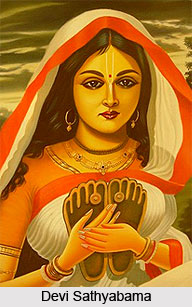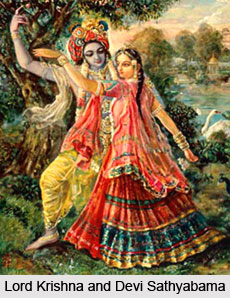 In the Puranas it is mentioned that Satyabhama is the daughter of Satrajit. Satyabhama is the third wife of Lord Krishna, renowned for both her strong will and bad temper. She is believed to be an Avatar or incarnation of Bhudevi.
In the Puranas it is mentioned that Satyabhama is the daughter of Satrajit. Satyabhama is the third wife of Lord Krishna, renowned for both her strong will and bad temper. She is believed to be an Avatar or incarnation of Bhudevi.
Satrajit was the owner of the Syamantaka jewel. Satrajit, secured the jewel from Surya and therefore never wanted to part with it even once when Krishna, asked for it he said that the jewel would be safe with him. After some time, Prasena, the brother of Satrajit went out hunting wearing the jewel but was killed by a lion. Then Jambavan (Jamvanta, Mythical Character) killed the lion and gave the jewel to his son to play with it. When Prasena did not return, Satrajit wrongly blamed Krishna for killing Prasena for the sake of the jewel.
Krishna to prove himself innocent set out in search of the jewel and found it in Jambavan`s cave, with his child. Jambavan attacked Krishna thinking him to be a trespasser who had come to take away the jewel. Both of them fought for continuous twenty eight days. At last Jambavan`s whole body was horribly wounded from the thrashing of Krishna`s fists. Jambavan recognised Him and surrendered. Jambavan was remorseful and gave Krishna the jewel.
Then Krishna returned the jewel to Satrajit, who also repented for his allegation. He offered Krishna the jewel and also wanted Krishna to marry his daughter Satyabhama . Krishna accepted Satyabhama`s hand but denied from accepting the jewel.
There is a legendary story related to Satyabhama and Narakasura. Narakasura was a demon king who ruled Pragjothishyapur. He was blessed by Lord Brahma that he would be unbeatable and would die only in the hands of his mother. Narakasura used this power of immortality and gradually became a dictator. He became infamous for his evil ruling and for disrespecting demigods and women. Narakasura defeated Lord Indra, king of gods, and snatched sixteen thousand women and imprisoned them in his palace. He once stole the earrings of Aditi, the heavenly mother goddess, and seized some of her territory. Aditi was a relative of Satyabhama. Satyabhama was believed to be an incarnation of Bhudevi and Bhudevi was Narakasura` mother. When Satyabhama heard of Narakasuara`s cruelty towards women and his behaviour with Aditi, she was infuriated. Satyabhama discussed this problem with Lord Krishna and took permission to declare a war against Narakasura. Krishna agreed and presented his Garuda as her mount and both rode to the city ruled by Narakasura.
In the war Satyabhama fought with Narakasura valiantly but he was more skillful. After a few days Narakasura got a chance to hurt Krishna. Krishna fainted as per the predestined divinely plan made with Satyabhama. When Satyabhama saw Narakasura attacking Krishna then she got furious. She doubled her strength and attacked the demon king Narakasura and finally. Before Narakasura`s death, he requested a boon from his mother, Satyabhama that everyone should celebrate his death with colourful lights. Accordingly this day is celebrated as the first day of Diwali or Naraka Chaturdashi.
After her victory, Satyabhama freed all the prisoners of Narakasura. Satyabhama rescued the sixteen thousand women and Lord Krishna married them for the reason of their purity which they preserved regardless of being made captives.
Satyabhama was proud of herself as she was loved by Lord Krishna. Suddenly one day Narada Muni arrived in Dwarka. Narada Muni said her that Lord Krishna`s love towards her is not real and that Krishna truly loves Rukmini, his first wife. He also said that Rukmini has the real control over his heart. Hearing all these Satyabhama became very jealous and was unable to tolerate what Narada said. She challenged Narada to prove him false.
Narada tricked Satyabhama into accepting a Vrata or ritual. In the ritual she has to give Krishna away in charity to Narada and to reclaim him by giving wealth in accord to Krishna`s weight (Tulabharam). Narada tempted her into accepting this vrata by telling her that Krishna`s love for her will be multiplied if she succeeds in performing this Tulabharam, weighing by scale. Narada also instigated her ego by hinting that her wealth may not be sufficient to equal the weight of Krishna. Satyabhama`s ego doubled and she told Narada that she can assemble enough wealth to outweigh Krishna.
Narada cautioned her that if she fails in her task then Lord Krishna will become his slave and has to work to please him. Satyabhama prepared herself for the Vrata and gave Krishna away in charity despite the pleading of the other wives of Krishna. Krishna being mischievous humbly submitted to this drama. After giving Krishna to Narada, Satyabhama arranged for a big weighing scale to be put up and send with all assurance for her huge treasure of gold and jewellery. All her possession was soon put on the scale, but the scale didn`t move. Narada started mocking her and threatened her that if Satyabhama can not put enough jewels then he will be enforced to auction Krishna as a slave to someone else. Satyabhama was frenzied and in panic consumed all her pride within herself and begged all the other wives to give their jewels. All the wives of Krishna agreed to give their jewels for their love for Krishna but unfortunately, it is of no use.
Lord Krishna remained speechless and mischieviously witnessed all this drama. Then to create more drama it was decided by Narada that Krishna would become a slave to some cowherd and will have to suffer the separation from his dear wife Satyabhama. Narada recommended Satyabhama that Rukmini may be able to get her out of the predicament. Finally Satyabhama got rid of her pride and pleaded to the devoted first wife of Krishna, Rukmini. Rukmini came and with a prayer to her husband put a single leaf of the sacred Tulasi on the scale or `tula`. The scale surprisingly became so heavy that even after removing all the jewels, the scales were weighed down on the side of the Tulasi leaf. This story describes the significance of Tulsi and how a humble offering to God is greater than any material wealth.




















